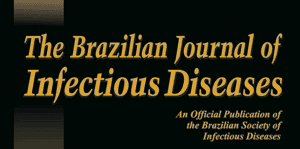Resumo em Inglês:
Renal TB is difficult to diagnose, because many patients present themselves with lower urinary symptoms which are typical of bacterial cystitis. We report a case of a young woman with renal TB and ESRD. She was admitted with complaints of adynamia, anorexia, fever, weight loss, dysuria and generalized edema for 10 months. At physical examination she was febrile (39ºC), and her abdomen had increased volume and was painful at palpation. Laboratorial tests showed serum urea=220mg/dL, creatinine=6.6mg/dL, hemoglobin=7.9g/dL, hematocrit=24.3%, leukocytes=33,600/mm³ and platelets=664,000/mm³. Urinalysis showed an acid urine (pH=5.0), leukocyturia (2+/4+) and mild proteinuria (1+/4+). She was also oliguric (urinary volume <400mL/day). Abdominal echography showed thick and contracted bladder walls and heterogeneous liquid collection in the left pelvic region. Two laparotomies were performed, in which abscess in pelvic region was found. Anti-peritoneal tuberculosis treatment with rifampin, isoniazid and pyrazinamide was started. During the follow-up, the urine culture was found to be positive for M. tuberculosis. Six months later the patient had complaints of abdominal pain and dysuria. New laboratorial tests showed serum urea=187mg/dL, creatinine=8.0mg/dL, potassium=6.5mEq/L. Hemodialysis was then started. The CT scan showed signs of chronic nephropathy, dilated calyces and thinning of renal cortex in both kidneys and severe dilation of ureter. The patient developed neurologic symptoms, suggesting tuberculous meningoencephalitis, and died despite of support measures adopted. The patient had ESRD due to secondary uropathy to prolonged tuberculosis of urinary tract that was caused by delayed clinical and laboratorial diagnosis, and probably also due to inadequate antituberculous drugs administration.
